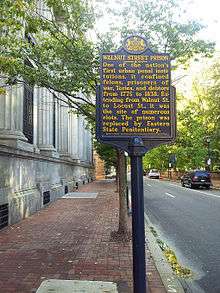Walnut Street Prison
.jpg) | |
| Location | Philadelphia, Pennsylvania, United States |
|---|---|
| Opened | 1773 |
| Closed | 1838 |
| Former name | Walnut Street Jail |
Walnut Street Prison was a city jail and penitentiary house in Philadelphia, Pennsylvania from 1773 to 1838.[1] Legislation calling for establishment jail was passed in 1773 to relieve overcrowding in the High Street Jail; the first prisoners were admitted in 1776.[2] It was located at Sixth and Walnut Streets, where it acquired its original name Walnut Street Jail.
The penitentiary house, built in 1790, is considered to be the first in the United States, as it was built to use individual cells and work details. The word "penitentiary" came from the Pennsylvania Quakers' belief in penitence and self-examination as a means to salvation. This was made a new and permanent form of combating crime through the practice of solitary confinement, which was later adopted at the Eastern State Penitentiary.
Architecture

The jail was designed to hold groups of inmates in large rooms. It was designed by Robert Smith, a prominent Philadelphia architect. The building was in the typical U-shape designed to hold large numbers of inmates. There was little regard for their physical well-being, and none for their rehabilitation. The prison was overcrowded and dirty, and inmates attacked each other regularly.
A new cellblock, called the "penitentiary house," was added in 1790. Built within the courtyard of the existing structure, it included a series of small cells for individual prisoners. The cells and the corridors connecting them were arranged to prevent prisoners from communicating with each other. Windows were high up (the cells had 9-foot-high (2.7 m) ceilings) and grated and louvered to prevent prisoners from looking onto the street. Each cell had a mattress, a water tap, and a privy pipe.
As a penitentiary, solitary confinement was the goal, but such facilities were available for about a third of those admitted. Other prisoners were made to sleep naked in a common room. Overcrowding undermined the goal of solitary confinement of serious offenders, and more than one inmate was placed in each cell. The isolation had a terrible psychological effect on inmates, and eventually inmates were given in-cell piecework on which they worked up to eight hours a day. Despite these difficulties, similar institutions were constructed in New York (Newgate in 1797) and New Jersey (Trenton in 1798).
Balloon flight
The first manned balloon flight in North America was made by Jean-Pierre Blanchard on January 9, 1793. He launched his balloon from the prison yard of the jail, before a crowd of spectators that included President George Washington, Vice-President John Adams, Thomas Jefferson, James Madison, and James Monroe. Blanchard crossed the Delaware River and safely landed in Deptford, New Jersey.[3]
References
- ↑ "Walnut Street Prison". Law Library - American Law and Legal Information Read more: Law Library. Retrieved 27 May 2011.
- ↑ Skidmore, Rex J., "Penological Pioneering in the Walnut Street Jail, 1789-1799", Journal of Criminal Law & Criminology, Vol. 35, no. 2, p. 167, 1948-1949.
- ↑ "Blanchard, Jean-Pierre-François." Encyclopædia Britannica Online. Retrieved 2009-10-17.
Further reading
- Inciardi, James A. Criminal Justice, Ninth Edition, McGraw-Hill, 2010.
- Manion, Jen. Liberty's Prisoners: Carceral Culture in Early America 2015, University of Pennsylvania Press
- Schmalleger, Frank, Corrections in the 21st century, Boston: McGraw-Hill, 2007.
- Siegel, Larry J. Essentials of Criminal Justice, Fifth Edition. Australia: Thomson Wadsworth, 2007.
- "Walnut Street Prison," Law Library - American Law and Legal Information. 30 Apr. 2009
- "The Prison Society - HISTORY." 30 Apr. 2009
Coordinates: 39°56′49″N 75°08′49″W / 39.947°N 75.147°W